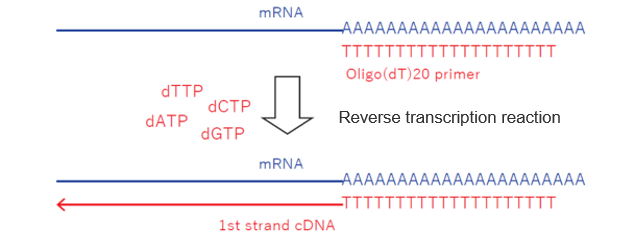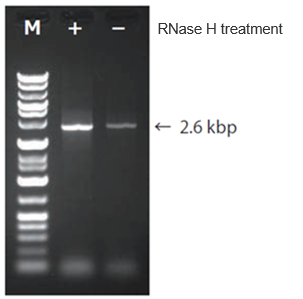Reverse Transcription
Reverse transcriptase is present in various organisms and viruses, and plays an important role in RNA research. The use of reverse transcriptase has remarkably advanced RNA expression analysis and DNA library construction. Fujifilm Wako provides reverse transcriptases that enable efficient reverse transcription, and cDNA synthesis kits.
More Information
What Is Reverse Transcriptase?
Reverse transcriptase is an enzyme that synthesizes complementary DNA (cDNA) using RNA as a template. Reverse transcriptase was discovered in a retrovirus, an RNA virus. After infecting a host cell, the retrovirus uses its reverse transcriptase to convert its genomic RNA into cDNA. At present, it is possible to synthesize cDNA in vitro using reverse transcriptase, and reverse transcriptase becomes an indispensable tool for gene expression analysis by reverse transcription-PCR (RT-PCR) (Figure1).

Figure 1 Reverse transcription reaction
(using oligo (dT) 20 primer and mRNA as a template)
Types of Reverse Transcriptase and Their Selection
Reverse transcriptases are used in experiments, including RT-PCR, and their advantages are summarized below.
AMV Reverse Transcriptase
AMV reverse transcriptase is derived from Avian Myeloblastosis Virus (AMV). AMV reverse transcriptase can perform reverse transcription reaction at a higher temperature (to 65°C) than the M-MLV reverse transcriptase described below, and therefore it can be used even when RNA with secondary structure or GC-rich RNA is used as a template. AMV reverse transcriptase has high RNase H activity, which cleaves double strands of DNA-RNA. However, the yield of cDNA tends to be low and it is said that the synthesis of long strands is difficult.
M-MLV Reverse Transcriptase
M-MLV reverse transcriptase is derived from Moloney murine leukemia virus (M-MLV). M-MLV reverse transcriptase has lower RNase H activity than AMV reverse transcriptase, and it can generate long-chain cDNA with a relatively high yield. M-MLV reverse transcriptase lacking RNase H activity is also marketed. As the reaction temperature (to 42°C) is lower than that of AMV reverse transcriptase, M-MLV reverse transcriptase is not suitable for reverse transcription of RNA with secondary structure.
Tth DNA polymerase
Tth DNA polymerase is derived from an extreme thermophile, Thermus thermophilus, and exhibits reverse transcription activity in the presence of Mn2+. As the reverse transcription reaction is possible at high reaction temperatures (60 to 70°C), it can be applied to reverse transcription of RNA with secondary structure and to GC-rich RNA, similar to AMV reverse transcriptase. As reverse transcription and DNA replication can be carried out with one enzyme, it is also used for 1-step RT-PCR, in which reactions from reverse transcription to DNA amplification are carried out in a single tube.
Is RNase H Unnecessary?
RNase H activity of reverse transcriptase cleaves double strands of DNA-RNA, and therefore reverse transcriptase lacking RNase H activity is commonly used to obtain full-length cDNA. However, the lack of RNase H activity may cause problems. In RT-PCR, remaining cDNA-RNA strands may prevent further cDNA amplification in subsequent PCR steps. To solve this problem, it is effective to synthesize cDNA using reverse transcriptase lacking RNase H activity and to treat with RNase H after the synthesis (Figure 2). A kit that combines reverse transcriptase lacking RNase H activity and RNase H, GeneAce cDNA Synthesis Kit from NIPPON GENE, for example, is an effective solution when the amplification efficiency of RT-PCR is not good (Figure 2).

Figure 2 PCR efficiency after RNase H treatment
cDNA was synthesized using the GeneAce cDNA Synthesis Kit with HeLa cell total RNA (2 μg) as a template. The PCR efficiency with and without RNase H treatment was compared using the obtained cDNA as a template.
Marker (M): Gene Ladder Wide 1 (Product No.: 313-06961)
Treated with RNase H (+): PCR product obtained using RNase H-treated (at 37°C for 15 minutes) cDNA as a template
Not treated with RNase H (-): PCR product obtained using untreated cDNA (DNA-RNA heteroduplex) as a template
Target of detection: A segment of EPAS1 gene (about 2.6 kb)
Primers Used for Reverse Transcription Reaction
The three types of primers mainly used in reverse transcription reaction are the following:
Oligo (dT) primer
An oligo (dT) primer binds complementarily to the poly A sequence at the end of eukaryotic mRNA. It can be used universally for mRNA to which poly A has been added, and is used for synthesis of full-length cDNA and 3'-RACE.
Random primer
As the name suggests, a random primer binds to a template RNA at random. A commonly used 6-base random primer is sometimes called a “random hexamer.” It can be used for reverse transcription reaction of RNA without poly A sequence, degraded RNA, and RNA that easily forms secondary structure.
Gene-specific primer
Gene-specific primers are designed to specifically bind to target RNA. They are used for 1-step RT-PCR. Their specificity is very high, and they cannot be used for amplification of RNA other than the target RNA.
References
Green, R. M. and Sambrook, J.: ”Molecular Cloning A Laboratory Manual, 4th ed.”, Cold Spring Harbor Laboratory Press, (2012).
For research use or further manufacturing use only. Not for use in diagnostic procedures.
Product content may differ from the actual image due to minor specification changes etc.
If the revision of product standards and packaging standards has been made, there is a case where the actual product specifications and images are different.
The prices are list prices in Japan.Please contact your local distributor for your retail price in your region.



